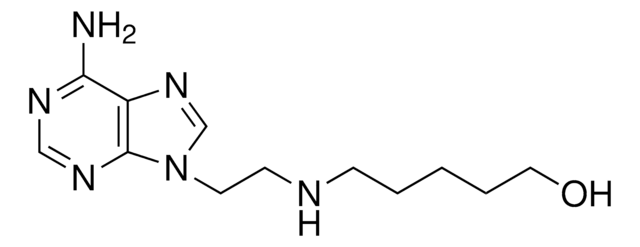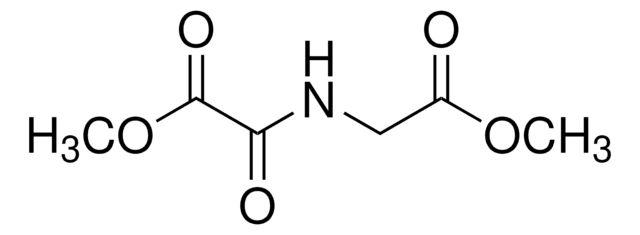A1439
Pituitary adenylate cyclase activating polypeptide-38
Sinonimo/i:
PACAP-38
Autenticatiper visualizzare i prezzi riservati alla tua organizzazione & contrattuali
About This Item
Formula empirica (notazione di Hill):
C203H331N63O53S
Numero CAS:
Peso molecolare:
4534.26
Numero MDL:
Codice UNSPSC:
41106305
NACRES:
NA.32
Prodotti consigliati
Forma fisica
powder
Livello qualitativo
Composizione
Peptide content, ~70%
N° accesso UniProt
Temperatura di conservazione
−20°C
Informazioni sul gene
human ... ADCYAP1(116)
Amino Acid Sequence
His-Ser-Asp-Gly-Ile-Phe-Thr-Asp-Ser-Tyr-Ser-Arg-Tyr-Arg-Lys-Gln-Met-Ala-Val-Lys-Lys-Tyr-Leu-Ala-Ala-Val-Leu-Gly-Lys-Arg-Tyr-Lys-Gln-Arg-Val-Lys-Asn-Lys-NH2
Descrizione generale
Pituitary adenylate cyclase activating polypeptide-38 (PACAP38) is mapped to human chromosome 18. 27-residue-amidated fragment (PACAP27) comprises another isoform. The PACAP38 is major isoform associated with mammals.
Applicazioni
Pituitary adenylate cyclase activating polypeptide-38 has been used to test its effect in stimulating the formation of cyclic AMP hypothalamus and cerebral cortex slices of chicken and to treat glioblastoma cells (U87MG) in cell migration assay to test its anti-invasive effects.
Azioni biochim/fisiol
Pituitary adenylate cyclase activating polypeptide-38 (PACAP38) is a cardioprotectant and may help in treating radiation-induced heart disease (RIHD). It plays a protective role during oxidative stress in cardiomyocytes. PACAP38 has antioxidant, anti-apoptotic and anti-inflammatory property. It is implicated in the pathophysiology of migraine and cluster headache.
PACAP-38 is a neuropeptide that has substantial sequence homology to vasoactive intestinal peptide (VIP). It is reported to serve as a neuronal survival factor.
Altre note
Lyophilized from 0.1% TFA in H2O
Codice della classe di stoccaggio
11 - Combustible Solids
Classe di pericolosità dell'acqua (WGK)
WGK 3
Punto d’infiammabilità (°F)
Not applicable
Punto d’infiammabilità (°C)
Not applicable
Dispositivi di protezione individuale
Eyeshields, Gloves, type N95 (US)
Certificati d'analisi (COA)
Cerca il Certificati d'analisi (COA) digitando il numero di lotto/batch corrispondente. I numeri di lotto o di batch sono stampati sull'etichetta dei prodotti dopo la parola ‘Lotto’ o ‘Batch’.
Possiedi già questo prodotto?
I documenti relativi ai prodotti acquistati recentemente sono disponibili nell’Archivio dei documenti.
I clienti hanno visto anche
T Dickinson et al.
Neuropharmacology, 38(1), 167-180 (1999-04-08)
Peripheral nerve damage often results in the development of chronic pain states, resistant to classical analgesics. Since vasoactive intestinal polypeptide (VIP) and pituitary adenylate cyclase-activating polypeptide (PACAP) are up-regulated in dorsal root ganglion cells following peripheral nerve injury, we investigated
L M E Pettersson et al.
The European journal of neuroscience, 20(7), 1838-1848 (2004-09-24)
In the present study, expression of pituitary adenylate cyclase-activating polypeptide (PACAP) in rat dorsal root ganglion (DRG) neurons and sciatic nerve following experimental sciatic nerve compression was studied with the use of quantitative immunohistochemistry and in situ hybridization. Previously, we
Grazia Maugeri et al.
Biomedicines, 9(8) (2021-08-28)
Pituitary adenylate cyclase-activating polypeptide (PACAP) exerts different effects in various human cancer. In glioblastoma (GBM), PACAP has been shown to interfere with the hypoxic micro-environment through the modulation of hypoxia-inducible factors via PI3K/AKT and MAPK/ERK pathways inhibition. Considering that hypoxic
Eloisa Rubio-Beltrán et al.
The journal of headache and pain, 19(1), 64-64 (2018-08-09)
Pituitary adenylate cyclase activating polypeptide-38 (PACAP38) is a widely distributed neuropeptide involved in neuroprotection, neurodevelopment, nociception and inflammation. Moreover, PACAP38 is a potent inducer of migraine-like attacks, but the mechanism behind this has not been fully elucidated.Migraine is a neurovascular
J Kinhult et al.
The European respiratory journal, 15(2), 243-247 (2000-03-08)
Pituitary adenylate cyclase-activating peptide (PACAP) 38 displays several biological activities relevant to obstructive airway disease. In this study, the occurrence of PACAP 38 in human small bronchi and corresponding pulmonary arteries was analysed immunocytochemically. The dilatory effects of this peptide
Il team dei nostri ricercatori vanta grande esperienza in tutte le aree della ricerca quali Life Science, scienza dei materiali, sintesi chimica, cromatografia, discipline analitiche, ecc..
Contatta l'Assistenza Tecnica.










